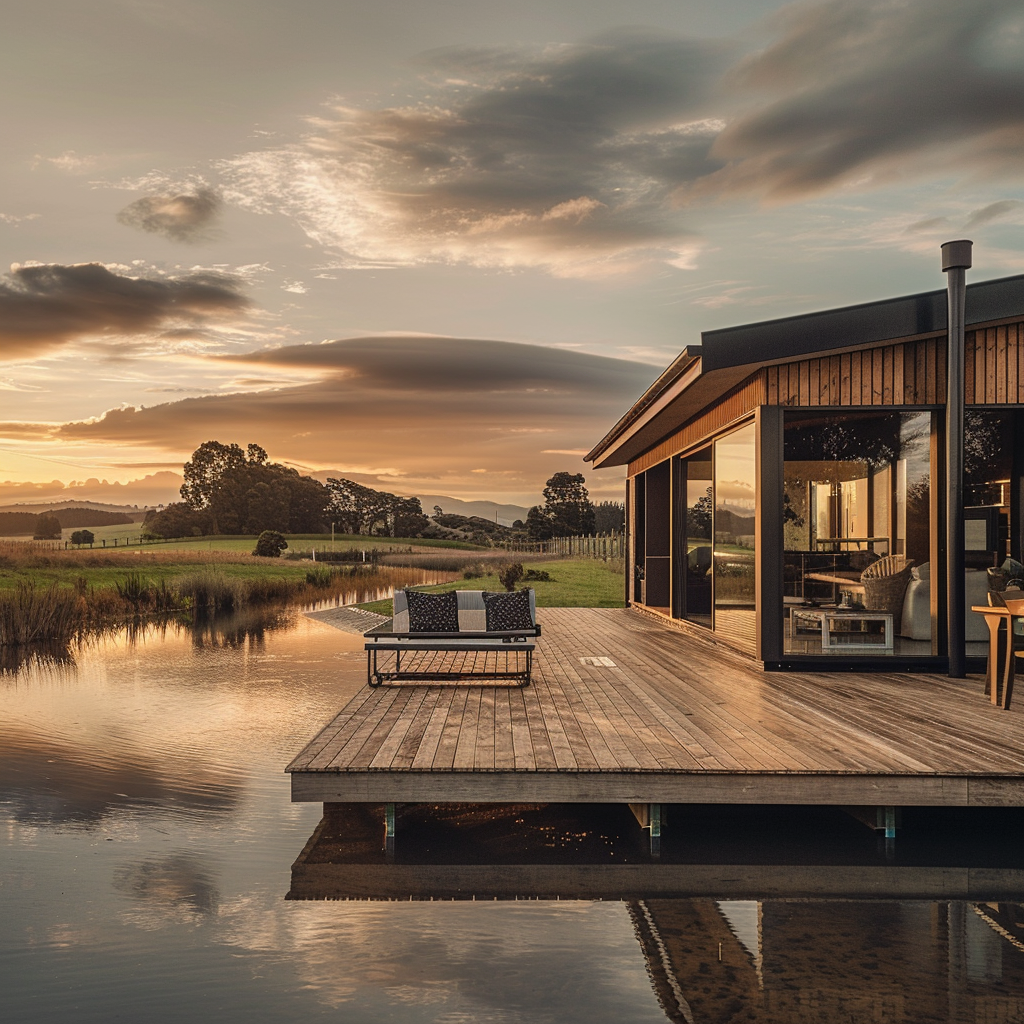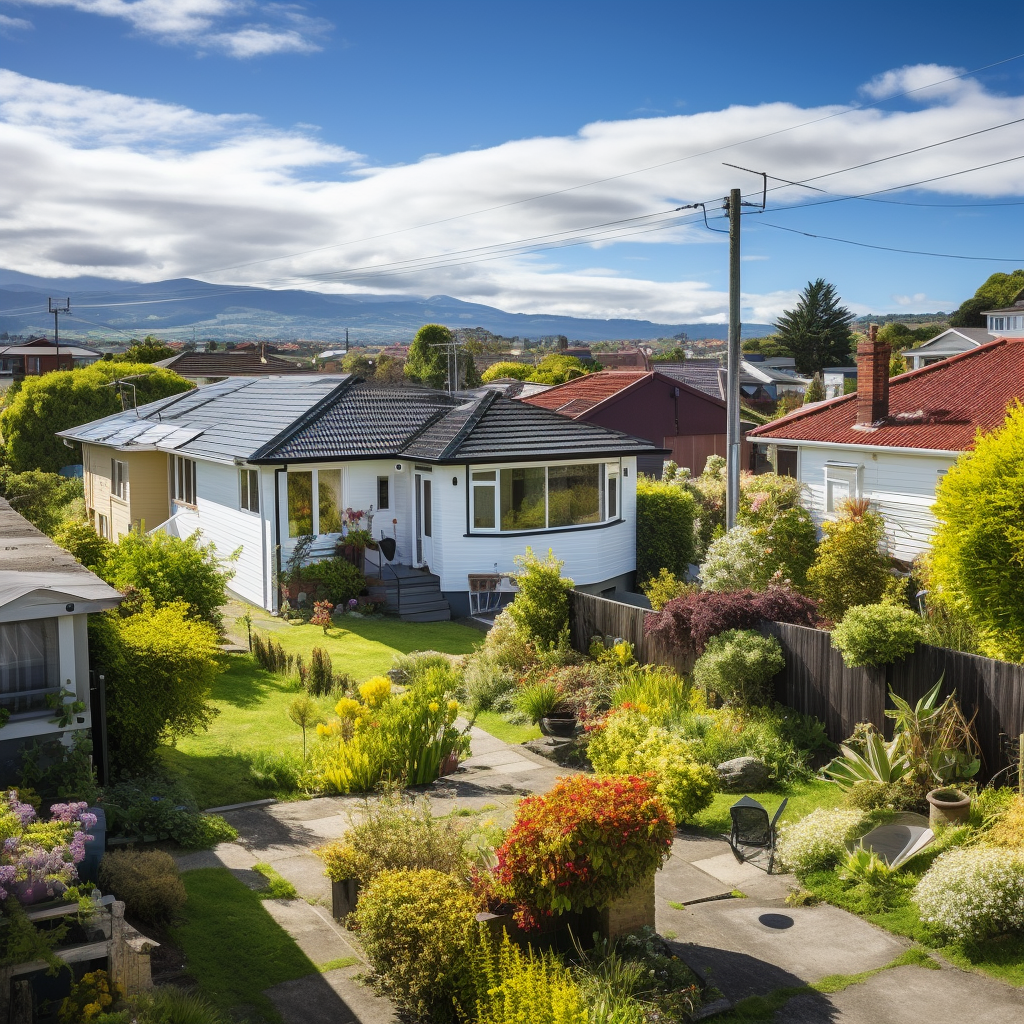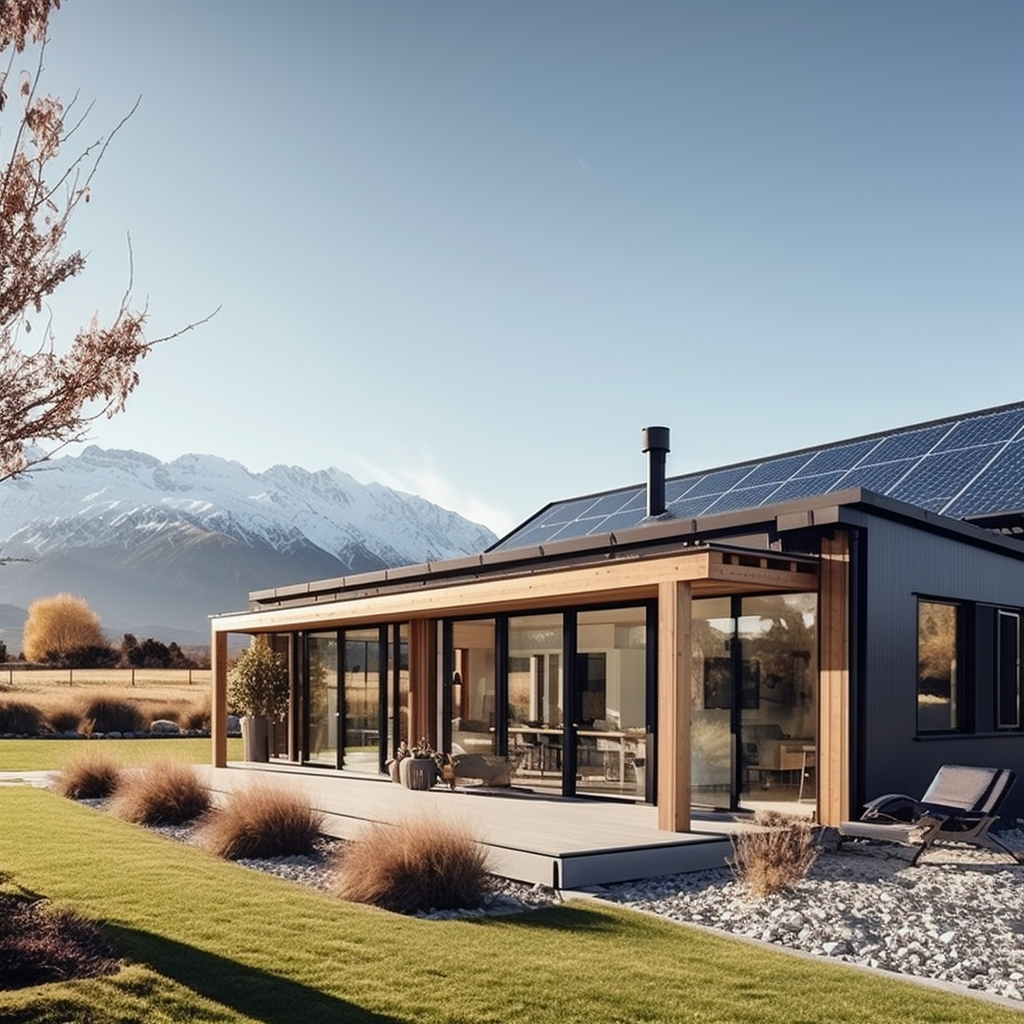Exploring the Rich Tapestry of Housing Options in New Zealand: From Urban Apartments to Rustic Farmhouses
Introduction: The Unique Blend of Urban and Rural Living in New Zealand's Diverse Home Styles
New Zealand is globally renowned for its awe-inspiring landscapes, from the rugged beauty of the Southern Alps to the serene beaches of Northland. These natural wonders are not just tourist attractions, but they also shape the country's built environment. The diverse landscapes and rich culture have influenced a broad spectrum of home styles that mirror the unique blend of urban and rural living in New Zealand.
From stand-alone houses nestled amidst sprawling green fields to modern apartments overlooking bustling cityscapes, diverse housing in New Zealand offers something for everyone. The Kiwi spirit is reflected in every brick and beam - whether it's the cosiness of a country cottage, the sophistication of a city townhouse, or the rustic charm of a beachfront bach.
This guide aims to take you on a journey through the wide range of housing options available in both urban and rural areas of New Zealand. Each style carries its own distinctive features and personality, shaped by factors such as architectural trends, geographical location, societal needs, and lifestyle preferences.
We'll explore New Zealand housing from various perspectives:
Advantages and challenges
Historical significance
Future trends
This will offer an enriching insight into what makes each home style unique in its own right. Welcome aboard this exciting expedition!
01. Stand-alone Houses
In the diverse landscape of New Zealand's housing options, stand-alone homes are a compelling choice. These residences, found in both cityscapes and rural settings, are a testament to suburban living. They offer an ideal environment for families who value privacy and space.
Stand-alone homes symbolise the quintessential essence of suburban living in NZ. They are defined by their isolation - with no shared walls or floors, these houses provide inhabitants with a sense of freedom and independence.
Advantages of Stand-Alone Homes
Stand-alone homes in NZ offer more than just seclusion. Their popularity stems from numerous benefits that cater to diverse lifestyle requirements:
A Backyard for Fun: Stand-alone homes often come with generous outdoor spaces. A backyard becomes a playground for kids - a place to run free, explore nature, or enjoy family picnics. It also serves as an ideal spot for BBQs during balmy summer evenings or hosting gatherings with friends and family.
Room to Grow: The freedom offered by stand-alone homes extends to future expansion possibilities. Whether you want to add an extra bedroom, construct a home office, or even build a separate guest unit, these houses offer flexibility that is often challenging to find in other housing types.
Make It Your Own: Owning a stand-alone home means having the liberty to customise it according to your preferences. From painting your front door in vibrant hues to landscaping your garden, there's no limit to personalisation.
Considering the Downsides
However, owning a stand-alone home isn't without its challenges. Here are some considerations that potential homeowners need to keep in mind:
- Maintenance Responsibilities: Homeownership comes with its fair share of chores - mowing the lawn, fixing broken fixtures, and general upkeep can be time-consuming. It's important to consider whether you're prepared for these additional responsibilities.
- Financial Implications: Stand-alone homes typically have higher purchasing and running costs compared to apartments or townhouses. You may need to plan for increased property taxes, utility bills, and maintenance expenses.
Architectural Styles: A Blend of History and Modernity
New Zealand's stand-alone houses are a canvas that beautifully blends historical architectural styles with contemporary designs:
Victorian Villas: These houses, common in city suburbs, are reminiscent of New Zealand's architectural heritage. Known for their intricate designs and spacious verandas, they offer a glimpse into the nation's past.
Contemporary Creations: In contrast, there are also ultra-modern homes that champion minimalistic design and sustainable features. These houses seamlessly fuse style with functionality, aligning with modern lifestyle preferences.
If you're contemplating building your own stand-alone home, consider using this New Zealand Property New Build Cost Calculator. It's a comprehensive tool that covers various construction costs — from site preparation to interior finishes.
Stand-alone homes in NZ offer a myriad of benefits but also pose certain challenges. The decision to invest in one depends on your personal needs, lifestyle choices, and budgetary constraints.
02. Townhouses
The townhouse lifestyle in NZ is a unique blend of personal space and community living. These multi-level homes are gaining popularity, particularly among those who wish to savour the city life without the burden of maintaining a large property.
The Best of Both Worlds: Privacy and Community
Townhouses present a balance between private homes and shared living spaces. Here's what sets them apart:
- Separate yet connected: Each townhouse features its own entrance and multiple floors, smartly separating living areas from bedrooms. This clever layout fosters a feeling of spaciousness and privacy within the home.
- Shared facilities: Townhouse complexes typically include amenities such as gardens and gyms that all residents can use. This shared access encourages a sense of community among neighbours, making it an ideal choice for those looking to forge new friendships in their neighbourhood.
Why Choose a Townhouse?
There's a myriad of reasons why townhouses are an appealing housing option:
- Lower maintenance: With external upkeep generally managed by a committee, townhouse owners can enjoy their weekends engaged in activities they enjoy rather than household chores.
- Affordability: In comparison to standalone houses, townhouses are usually more cost-effective, opening up homeownership to a broader demographic.
- Safety: Living in close quarters with others often results in a safer environment, with communal areas and collective vigilance adding to overall security.
- Convenience: Townhouses are commonly located in prime urban locales, within easy reach of amenities like cafes, parks, and public transportation systems.
The Changing Face of Townhouses
Townhouses, like other architectural styles, have evolved over time to cater to the contemporary resident's needs. Some noteworthy advancements include:
Utilisation of sustainable materials for construction
Integration of solar panels for harnessing renewable energy
Incorporation of rainwater harvesting systems
Promotion of communal gardens for eco-conscious living
These enhancements not only have a positive impact on the environment but also create healthier living environments and lower utility costs.
Modern Townhouse Designs in NZ
Modern townhouses in New Zealand leverage the latest design trends to enhance comfort and functionality:
- Open-plan layouts to invite natural light
- Integration of smart home technology for additional convenience
- Ingenious storage solutions to optimise available space
These features cater to the evolving preferences of Kiwis who desire urban homes that are both stylish and practical.
Whether you're mulling over a townhouse or are simply intrigued by this housing option, exploring various developments can shed light on what might align with your lifestyle. From eco-friendly initiatives to innovative design elements, there's something for everyone in today's dynamic townhouse market.
By gaining a deeper understanding of these key facets of townhouse living in New Zealand – from shared amenities to evolving designs – potential buyers can make informed decisions that match their personal needs and aspirations.
03. Apartments
Amidst the hustle and bustle of New Zealand's vibrant cities, apartment living has emerged as a popular choice for many. These dwellings range from quaint low-rise blocks to awe-inspiring high-rise structures that reach towards the sky, offering a distinct urban living experience. Such city abodes are particularly appealing to individuals who relish the pulsating energy of metropolitan areas and appreciate having convenience right at their doorstep.
The Allure of Apartment Living
The advantages of opting for an apartment lifestyle are manifold:
A. Unmatched Convenience
One of the key perks of apartment living is their prime locations. Often situated in the heart of the city, residents enjoy unparalleled access to workplaces, entertainment hubs, and essential amenities. This strategic positioning translates into less commute time, thereby allowing more opportunities to relish the pleasures of urban life.
B. Stellar Amenities
A significant number of apartment complexes boast superior facilities like gyms, swimming pools, and shared spaces that enrich the quality of life. The best part? Residents can enjoy these perks without worrying about upkeep or maintenance.
C. Robust Security
Apartments typically come with enhanced security features such as controlled access and sophisticated surveillance systems, ensuring residents' safety and peace of mind.
D. Fostering Community
Living in close quarters with others promotes a sense of community spirit and offers ample chances to forge new friendships.
Navigating Urban Challenges
While apartments offer an enticing blend of excitement and convenience, they also present a unique set of challenges:
E. Noise Pollution
Owing to densely populated urban settings, noise levels can be higher due to traffic or close-by neighbors. Therefore, it's crucial for potential buyers or tenants to consider apartments with soundproofing features or quiet locales.
F. Limited Outdoor Space
For most apartment dwellers, balconies or small terraces might be the only personal outdoor space available. This makes access to public parks an integral aspect of urban planning, ensuring residents can still enjoy a bit of greenery.
Sustainable Features in New Zealand Apartments
Sustainability isn't just a trendy catchphrase; it's a vital element of contemporary construction practices. New Zealand plays host to numerous avant-garde apartment complexes that incorporate eco-friendly designs:
G. Energy Efficiency
Many apartments are fitted with cutting-edge smart home technologies designed to lower energy consumption through efficient heating, cooling, and lighting systems.
H. Water Conservation
Innovative features such as rainwater harvesting systems and low-flow fixtures are installed in apartments to encourage responsible water usage.
I. Green Spaces
The inclusion of vertical gardens and rooftop green spaces not only enhances the aesthetic appeal of the building but also boosts air quality and provides residents with a refreshing touch of nature.
These sustainable initiatives resonate with New Zealanders' profound respect for their environment and address pressing global concerns about resource utilization and climate change.
Financial Considerations
Financing an apartment purchase involves exploring various mortgage options. Resources provided by Realtor.co.nz, such as the Mortgage Term Payment Comparison Calculator, can assist individuals in comparing payments across different loan tenures—pivotal for making well-informed financial decisions tailored to individual needs.
Choosing an apartment in New Zealand involves balancing lifestyle preferences with practical factors. Be it the allure of city lights or a commitment towards sustainable living, apartments provide diverse possibilities for those keen on experiencing a slice of urban New Zealand life.
04. Units and Duplexes
Moving away from traditional housing models, units and duplexes in New Zealand offer a different way to find a balance between comfort, affordability, and location. These options are especially appealing to first-time home buyers and experienced property investors who want something different.
Units: Small and Simple Living Spaces
Units are small self-contained residences usually found in multi-unit buildings. They're like smaller versions of standalone houses, but with shared walls. Typically, units have one or two bedrooms, a bathroom, kitchen, and living area – all designed to fit into a small space.
Why People Choose Units
There are several reasons why people choose units as their homes:
- Less Maintenance: With less space to clean and take care of, units are perfect for those who want a low-maintenance property.
- Great Location: Many unit buildings are in urban areas near shops, restaurants, and public transportation. This means having everything you need within walking distance.
However, it's important to note that living in a unit also has its challenges. Limited space may not be suitable for everyone, and privacy can be an issue with neighbors so close by.
Duplex Properties: Two Homes in One
Now let's talk about duplex properties – these are essentially two independent residences under one roof. Each side is the same in layout and design but has its own entrance and services.
Duplex properties combine the idea of living together with some level of privacy, making them great for extended families or friends who want to live close but still have their own space. They're also attractive to property investors looking for multiple rental incomes.
The Unique Benefits of Duplex Properties
These properties stand out in the New Zealand housing market because of their mix of shared and independent living:
Each half of the duplex can accommodate a different household, allowing for diversity in age, family size, or lifestyle under one roof – a testament to New Zealand's inclusive community spirit.
Duplex properties provide an opportunity for extended families to live close together while still having their own homes.
For property investors, duplexes offer the chance to earn rental income from both sides of the property.
It's important to consider all aspects before deciding to buy a duplex property. While they offer unique benefits, the cost of purchasing a duplex can be higher than buying a single-family home. However, this cost can often be balanced out by the potential rental income if one side is rented out.
As with any property purchase, it's crucial to think about your needs, budget, and goals before making a decision. If you're considering buying a property in New Zealand and want to keep track of your mortgage progress, you can use the Principal Payback Milestone Calculator provided by realtor.co.nz. This tool will help you assess your mortgage repayment milestones over time and make informed choices about your investment.
05. Embracing Nature: Lifestyle Blocks and Baches (Beach Houses)
New Zealand’s diverse housing landscape caters to a range of lifestyle preferences, offering particularly enticing options for those desiring a life closer to nature. Lifestyle blocks in Aotearoa, also known as 'lifestylers', provide an idyllic setting for embracing rural living without forsaking the convenience and accessibility of modern amenities. These larger rural properties, typically ranging from one to 20 hectares, serve as perfect canvases for individuals and families eager to explore self-sufficiency, whether it's through cultivating their own gardens, tending to orchards, or raising livestock.
Lifestyle Blocks: The Allure of Rural Living
Lifestyle blocks, a quintessential New Zealand housing option, offer expansive land parcels that allow plenty of room for creativity and personal expression. Here are some key aspects that make this choice attractive:
Space and Privacy: With such large plots of land, homeowners enjoy unparalleled privacy and the freedom to create their personal oasis away from urban hustle.
Agricultural Opportunities: Lifestyle blocks cater to both hobby farming enthusiasts and commercial agricultural ventures, providing ample space for a variety of activities.
Community Spirit: Despite the physical distance between properties, rural communities often boast strong neighborly connections and provide a supportive network.
Owning a lifestyle block comes with its unique set of challenges. These include understanding land management principles and handling infrastructure maintenance. However, many find the rewards - sweeping rural views, fresh air and the satisfaction derived from land stewardship - more than compensate for these efforts.
Kiwi Bach Culture: The Coastal Retreat
Baches, or beach houses, encapsulate the enduring spirit of New Zealand’s coastal culture. Initially simple holiday homes where families could unwind and connect with nature, many baches have evolved into stylish coastal properties without losing their original charm.
Holiday Homes & Getaways: Baches provide a tranquil escape from the routine, ideal for holidays or weekend getaways.
Simplicity and Charm: Baches are often praised for their no-fuss, laid-back vibe. The emphasis is on relaxation and enjoyment rather than ostentatious luxury.
Coastal Connection: Proximity to the sea offers a variety of recreational activities like water sports, fishing, beachcombing, and beachside barbecues.
Despite their humble beginnings, some baches in prime locations have morphed into upscale dwellings that seamlessly blend rustic charm with modern conveniences. Whether you opt for a traditional bach or a contemporary version, these coastal properties remain an integral part of Kiwi summer traditions.
Financial Considerations: Renting vs Owning
Ownership of a lifestyle block or bach may seem daunting due to potential costs. To help prospective homeowners assess their financial capacity, the NZ Rent Affordability Calculator on realtor.co.nz is an excellent tool. It provides insightful data on what one can comfortably afford when renting properties similar to these unique homes.
As you contemplate the dream of rural or coastal living in New Zealand, remember that each housing choice reflects individual preferences and priorities. Whether it’s the vast open spaces of a lifestyle block or the seaside allure of a bach, there exists an option that resonates with the values and aspirations uniquely associated with life in New Zealand.
6. Compact Urban Living: Terraced Houses and Tiny Houses
As New Zealand's population continues to grow and urban centres become more vibrant, the need for innovative, space-efficient housing solutions increases. Terraced housing in NZ, also known as row houses, emerges as a practical solution in these densely populated areas.
Terraced Housing: A Detailed Exploration
Terraced houses, characterised by their shared walls and consistent appearance, create an unbroken row that is not only aesthetically pleasing but also maximises land use. This is especially critical in cities where space is a high-value commodity.
Advantages of Terraced Houses:
- Space Efficiency: Terraced houses excel in compactness. Their design enables more residents to live within the city's heart, close to essential amenities.
- Community Environment: The close-knit nature of these residences often fosters a community spirit, with neighbors sharing spaces such as gardens or courtyards.
- Architectural Diversity: Despite the structural similarities, terraced houses can exhibit a broad range of architectural styles. From classic Edwardian and Victorian terraces to contemporary interpretations featuring eco-friendly elements.
Investors keen on terraced properties can utilise the Property Capitalisation Rate Calculator on realtor.co.nz. This tool evaluates potential returns on investment properties by calculating the capitalization rate based on net operating income and market value.
The Tiny House Movement: A New Zealand Perspective
The concept of home is also being reimagined due to the tiny house movement NZ. This trend has gained traction among Kiwis seeking simplicity, sustainability, and financial independence.
Factors Driving the Popularity of Tiny Houses:
- Sustainability: Tiny houses are often constructed using eco-friendly materials and designs, substantially reducing occupants' ecological footprint.
- Affordability: The reduced dimensions result in lower construction and maintenance costs, making homeownership more feasible.
- Mobility: A significant number of tiny homes are built on trailers, providing owners the freedom to relocate their home as necessary – a contemporary take on nomadic living.
Despite their compact size, tiny houses can be surprisingly luxurious and functional. Ingenious storage solutions and versatile furniture enable residents to enjoy modern conveniences without the need for substantial space.
Embracing Innovative Design
Both terraced housing and tiny homes rely heavily on innovative design principles. As land availability dwindles and environmental concerns escalate, architects are tasked with creating spaces that are compact, comfortable, and energy-efficient.
Sustainable Elements:
- Terraced housing often includes features like shared heat pumps or solar panels to minimise energy consumption.
- Tiny houses may incorporate composting toilets or rainwater collection systems to reduce their environmental impact even further.
Impact on New Zealand Communities
The influence of both terraced housing and tiny homes is increasingly visible across New Zealand's urban and rural landscapes. In cities like Auckland and Wellington, terraced developments contribute to neighborhood revitalization efforts and provide more housing options near employment hubs and recreational areas. Conversely, rural regions see an influx of tiny homes amidst picturesque settings, offering sanctuaries from busy city life or viable options for those seeking to downsize.
These housing alternatives signify a societal shift towards conscious living – a realm where quality trumps quantity, community triumphs over isolation, and sustainability prevails over wastefulness. This transformation isn't.
7. Preserving Heritage: Cottages, Villas, and Converted Warehouses
New Zealand's residential architecture tells a story of cultural heritage and historical significance. Among these, cottages in New Zealand present a quaint beauty that has become an iconic part of the nation's architectural history.
These charming residences often feature traditional architecture with their distinctive timber frames, sash windows, and corrugated iron roofs. Stepping into a cottage is like stepping back in time, where one can almost hear the echoes of early settler life.
Cottages are not only aesthetically pleasing but also symbolise the craftsmanship and durability of older construction methods. Many families treasure these homes for their character and the sense of history they bring to everyday living.
The Allure of Historic Villas
Transitioning from the rustic allure of cottages to the elegance of grander structures, historic villas NZ stand as testaments to the prosperous times of the late 19th and early 20th centuries.
These heritage homes often boast intricate woodwork, high ceilings, and expansive verandas. The charm of these elegant residences is captivating; however, they do come with unique challenges.
Preserving a historic villa requires commitment and sensitivity to its original design while updating it to meet modern living standards. Owners of these precious pieces of history are tasked with balancing restoration with renovation—a delicate dance between maintaining authenticity and ensuring functionality.
When considering buying one, understanding property value takes on an additional layer as heritage status can influence worth significantly—something buyers can learn more about through resources like Understanding Property Value in NZ: Essential Buyer's Guide.
Innovative Warehouse Conversions
The narrative of New Zealand’s housing styles would be incomplete without mentioning the inventive transformation of warehouse conversions NZ. These industrial heritage buildings have been ingeniously adapted for residential use, offering spacious contemporary living spaces within robust historical shells. Once bustling centers for trade and industry, these buildings now serve as unique dwellings that appeal to those who appreciate urban aesthetics mixed with industrial charm. High ceilings and open floor plans characterise warehouse conversions, providing a canvas for modern design elements while preserving original features such as exposed brickwork and steel beams.
These conversions exemplify how cities across New Zealand are embracing their past by repurposing old structures rather than building anew—a sustainable approach that resonates with many Kiwis passionate about conservation and innovation in urban development.
Each housing style discussed here represents a facet of New Zealand’s rich tapestry of home options, reflecting both reverence for tradition as well as adaptability towards modern living requirements.
As residents continue to cherish these varied forms of accommodation, they contribute to the evolving narrative of New Zealand's residential landscape—one that honors its roots while boldly moving into the future.
8. Addressing Housing Affordability: State Houses and Social Housing Developments
New Zealand's housing landscape is as diverse as its people, featuring everything from historic cottages to modern apartments. Yet, amidst this variety, the issue of affordability remains a constant challenge. This section delves into the world of state houses and social housing units, two key strategies in New Zealand's mission to ensure everyone has access to a comfortable home.
State Houses: Providing Stable Homes for Those in Need
State housing insights NZ reveal that these government-provided homes play a crucial role in providing long-term, stable accommodation for low-income individuals and families. Birthed in the 1930s during the Great Depression, state houses were a beacon of hope for many Kiwis struggling with homelessness or inadequate living conditions.
Did you know? The first state house was built in Wellington in 1937 and is now a significant part of New Zealand's architectural history.
State houses are designed to be economical yet comfortable, offering all the necessary amenities without any extravagant frills. While their design may vary from one neighbourhood to another, they generally feature three bedrooms, a separate lounge, kitchen, laundry area and bathroom - all meticulously planned for optimal functionality.
However, state housing is more than just a roof over your head; it is an opportunity for individuals and families to establish stability and improve their overall quality of life. By ensuring affordable accommodation, residents can focus on other aspects such as education, employment or personal growth without being burdened by exorbitant rental costs.
Social Housing Initiatives: Building Sustainable Communities
In addition to state houses, social housing initiatives also play a significant role in addressing the issue of affordability in New Zealand. These initiatives encompass both public projects led by the government and community-driven projects managed by non-profit organisations or iwi groups.
Social housing units aim to provide not just affordable homes but sustainable communities where residents can thrive. They often include additional services such as financial counselling, employment support or community programs to help residents achieve greater independence and financial stability.
Creating a Better Future Through Affordable Housing
These housing options reflect New Zealand's commitment to ensuring everyone has access to quality housing, regardless of their income level. Through state houses and social housing developments, communities across the country are empowered with affordable, stable homes that lay the foundation for a better future.
While these homes may not feature grand facades or luxurious interiors, they carry a unique charm of their own. They represent resilience, community spirit and the Kiwi ethos of providing a fair go for all.
As you explore your property options on realtor.co.nz, remember that whether it's a state house or a beachfront bach, every home tells a story. And who knows? The next chapter of your story might just start in one of these affordable housing options.
9. Future Trends: Modular Homes, Co-housing Communities, and Property Value Growth
The New Zealand housing landscape is continually evolving, with innovative construction methods and community-focused living arrangements paving the way for a more sustainable and inclusive future. Two trends capturing the imagination of homeowners and developers alike are modular housing and co-housing communities. Additionally, there is a growing interest in tracking property value growth using tools like the Property Capital Value Change Calculator.
Modular Housing in NZ
Modular homes, also known as prefabricated homes, have surged in popularity due to their remarkable efficiency and environmental benefits. This method involves sections of a house being constructed off-site in a controlled factory setting before being transported to the final location for assembly.
Benefits of Modular Housing
- Speed of Construction: One of the most compelling advantages of modular homes is the accelerated timeline from concept to completion. With fewer weather delays and streamlined production processes, these homes can be ready for occupation significantly faster than traditional builds.
- Sustainable Design: Prefabricated construction is a beacon of sustainable design within the industry. By reducing waste, improving energy efficiency, and utilizing eco-friendly materials, these homes are designed with a lower carbon footprint in mind.
- Cost-Effectiveness: The precise nature of factory builds can also lead to cost savings by minimizing unforeseen expenses and material overruns commonly encountered on-site.
- Quality Control: Operating in a controlled environment allows for higher precision in construction, which can result in better build quality and less post-construction issues.
Despite these benefits, it's crucial to recognise that modular housing faces challenges such as transportation logistics and the need for suitable land. However, as technology advances and public interest grows, modular housing is set to become an increasingly visible part of New Zealand's residential fabric.
Co-housing in New Zealand
Co-housing offers an alternative approach by emphasizing community collaboration. In co-housing setups, residents actively engage in both the design process and ongoing management of their living environment.
Features of Co-housing
- Community Engagement: Residents share common facilities while maintaining private residences. This balance fosters a tight-knit community where social interaction is part of daily life.
- Resource Sharing: Co-housing promotes the sharing of resources like tools, vehicles, or even childcare responsibilities. This not only reduces costs but also strengthens communal bonds.
- Environmental Impact: These communities often prioritise sustainability through shared gardens, renewable energy systems, and green building practices.
Creating such communities demands careful planning and a commitment to collective decision-making. While co-housing is still relatively niche in New Zealand, its potential for fostering supportive networks makes it an attractive prospect for many seeking more than just a home but a connected way of life.
Both modular housing and co-housing reflect a shift towards more conscious living—where efficiency, sustainability, and community are at the heart of home design. As these trends gain momentum, they offer intriguing possibilities for addressing some of the contemporary challenges faced by New Zealand's housing sector.
New Zealand's architectural landscape showcases its diversity, reflecting its unique culture and way of life. From urban apartments to rustic farmhouses, there is a wide range of home styles available in the country.
Embrace the diversity of housing options in New Zealand. Let your personal values and lifestyle needs guide your journey to find the perfect home. Whether you prefer a historic villa or a sustainable modular home, there is no one-size-fits-all solution.
Understanding the Relationship Between Architecture, Culture, and Lifestyle
The exploration of various housing options in this guide provides insights into the intricate relationship between architecture, culture, and lifestyle in New Zealand. It's not just about buildings; it's about creating communities that resonate with Kiwi values.
Your journey towards finding your ideal home in New Zealand may be just beginning. Whether you're a first-time buyer or an experienced investor, remember that knowledge is power. Understanding the variety of housing options available allows you to make informed decisions that align with your lifestyle needs and values.





-1704306197.png)
